The Ellora Caves, a UNESCO World Heritage Site, are a marvel of ancient Indian rock-cut architecture. Located in the Aurangabad (Sambhajinagar) district of Maharashtra, these caves represent an exceptional achievement of Indian art and engineering. This site is home to 34 caves that were excavated from the Charanandri hills and date back to 600-1000 CE. The Ellora Caves are not just a single religious complex but a unique fusion of Buddhist, Hindu, and Jain monuments, illustrating the spirit of religious tolerance that was prevalent in ancient India.

Table of Contents
Historical Significance
The construction of the Ellora Caves took place over several centuries under the patronage of various dynasties. The earliest Buddhist caves date from 600 to 730 CE, during the time of the Rashtrakuta dynasty. The Hindu caves, including the renowned Kailasa temple, were primarily constructed between 600 to 900 CE. The Jain caves were created around 800 to 1000 CE, demonstrating the coexistence and harmony between different religious traditions.
The caves were an important center for trade and religious activity, attracting pilgrims, scholars, and traders from various parts of the ancient world. The intricate carvings and sculptures provide insight into the artistic and cultural influences of the time, reflecting the blending of local and foreign styles.
Architectural Marvels
Buddhist Caves (Caves 1-12)
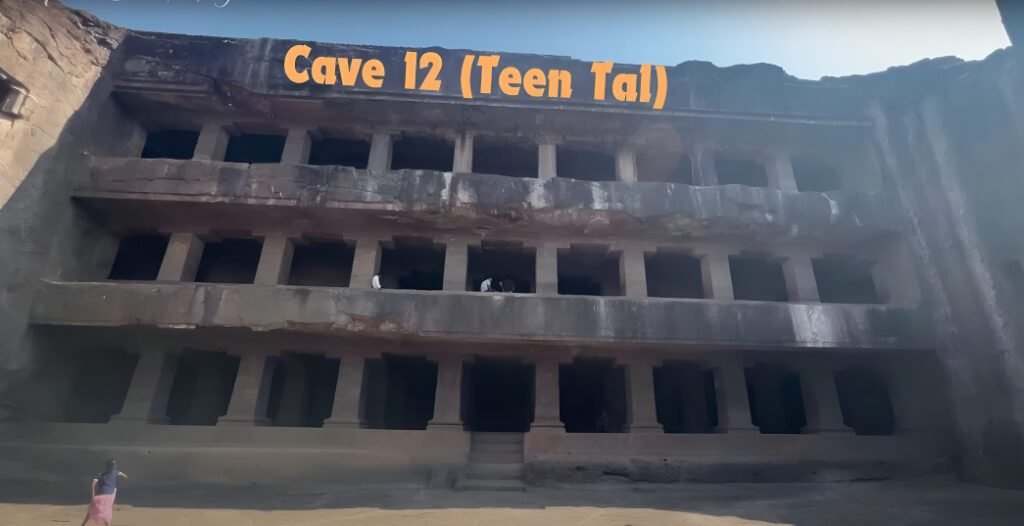
The Buddhist caves are some of the earliest structures at Ellora. These caves include monasteries (viharas) and prayer halls (chaityas). Cave 10, known as the ‘Vishvakarma Cave,’ is particularly notable for its cathedral-like design and a large seated Buddha in a preaching pose. The intricate carvings and stupas in these caves reflect the spread of Buddhism and its artistic heritage.
Cave 1
Structure: Cave 1 is a simple monastery consisting of a hall and eight small cells.
Design: The cave features a basic, unadorned design, typical of the early phase of rock-cut architecture at Ellora.
Function: It served as a residence for Buddhist monks, providing them with living quarters and meditation spaces.
Historical Significance: As one of the earliest Buddhist caves, it marks the beginning of Buddhist monastic architecture at Ellora.
Condition: The cave is well-preserved, offering a glimpse into the austere living conditions of the monks.
Cave 2
Structure: Cave 2 is a hermitage with four pillars and a central hall with beautifully carved figures of Buddha.
Interior: The walls and pillars are adorned with carvings of Buddha in various poses, along with bodhisattvas and other figures.
Stupas: It includes several stupas, which are significant as symbols of Buddhist worship and relics.
Historical Art: The detailed carvings illustrate the artistic development and iconography of early Buddhist art.
Function: The cave served as a meditation and assembly hall for monks, reflecting the community’s religious practices.
Cave 10 (Vishvakarma Cave)
Design: Named after the architect of the gods, Known as the ‘Vishvakarma Cave’ or ‘Carpenter’s Cave,’ it features a vaulted ceiling that imitates wooden beams, showcasing the craftsmanship of ancient artisans.
Buddha Statue: A large seated Buddha in a preaching pose dominates the interior, symbolizing the spread of Buddhist teachings.
Stupa: The cave contains a large stupa at the rear, serving as a focal point for worship.
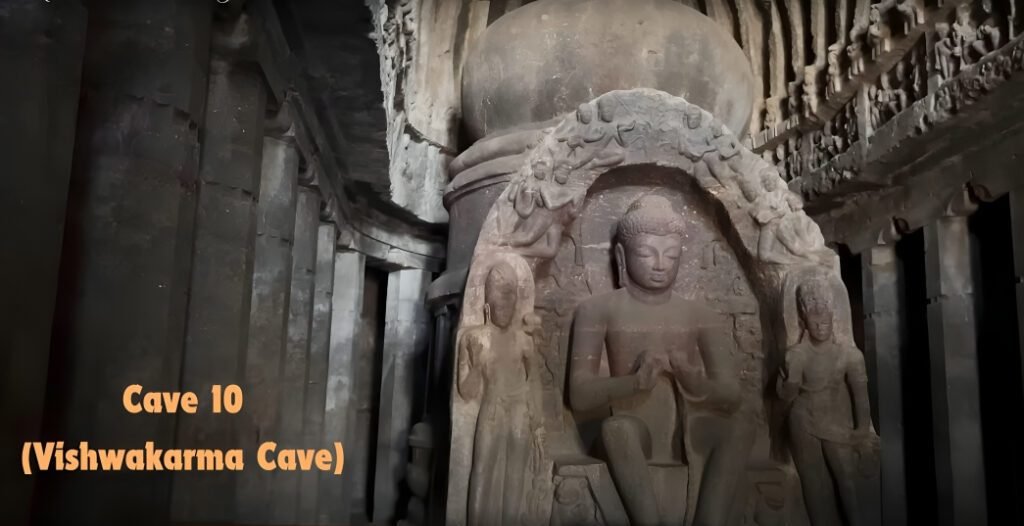
Acoustics: The cave is famous for its excellent acoustics, often compared to that of a cathedral, making it a popular site for religious chanting and ceremonies.
Carvings: Intricate carvings on the walls depict various scenes from Buddha’s life and other Buddhist iconography, highlighting the narrative art of the period.
Hindu Caves (Caves 13-29)
The Hindu caves are renowned for their extraordinary rock-cut architecture and detailed sculptures. The most iconic structure is Cave 16, the Kailasa temple. This monolithic structure, carved out of a single rock, represents Mount Kailasa, the abode of Lord Shiva. The temple is a testament to the engineering prowess of ancient Indian craftsmen, featuring intricate carvings of deities, mythological scenes, and architectural elements like pillars and courtyards.
Cave 15 (Dashavatara Cave)
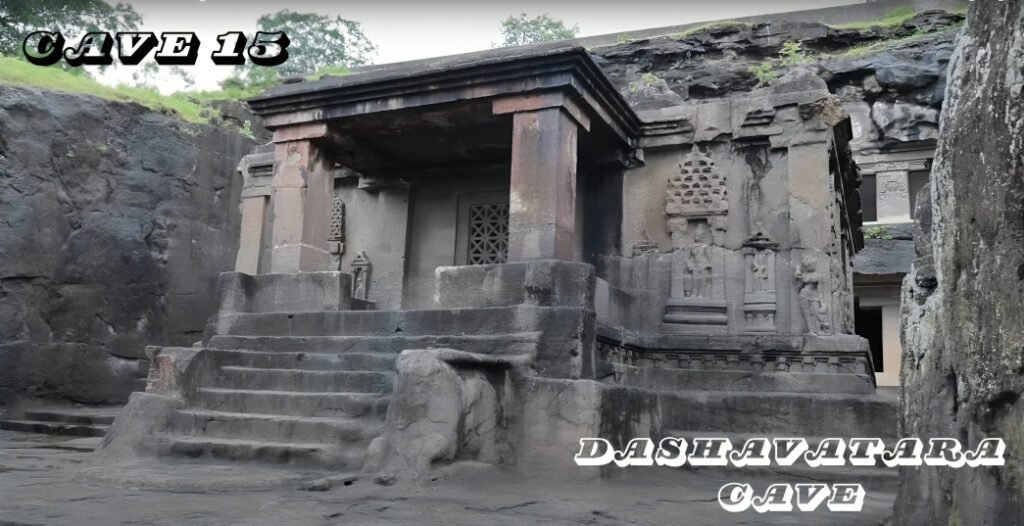
Court Hall: The upper level has a spacious court hall with a central shrine dedicated to Lord Shiva, reflecting the syncretism of Hindu worship practices.
Historical Layers: The architecture and iconography provide insights into the evolution of Hindu temple design and religious art over time.
Multi-level Structure: This cave is a two-storied structure with elaborate sculptures on both levels.
Dashavatara Panels: It is named for the detailed panels depicting the ten avatars of Vishnu, including scenes like the churning of the ocean.
Iconography: The cave contains significant carvings of various Hindu deities, illustrating key mythological stories.
Cave 16 (Kailasa Temple)
Monolithic Structure: The crown jewel of Ellora,The Kailasa temple is a massive monolithic structure, carved from a single rock, representing Mount Kailasa, the abode of Lord Shiva. Looking at this temple from above, it looks like a chariot And this temple took about 200 years to build.
Architectural Feat: It is considered one of the largest rock-cut monuments in the world, illustrating the peak of Indian rock-cut architecture.
Intricate Carvings: The temple features elaborate carvings depicting scenes from Hindu epics like the Ramayana and Mahabharata, as well as various deities.
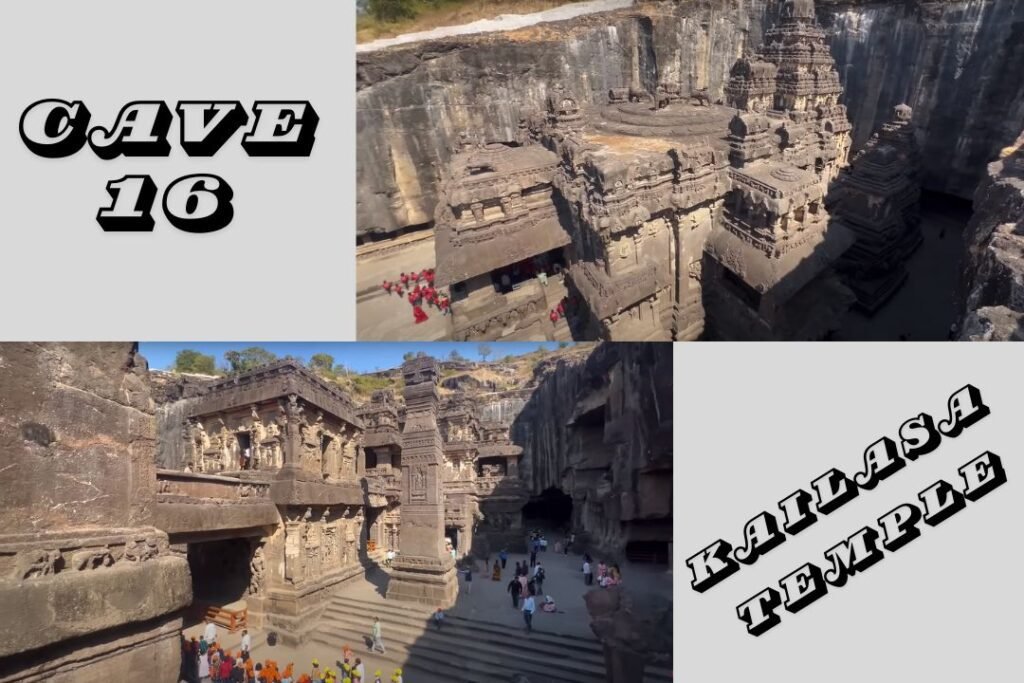
Courtyard: The temple has a large U-shaped courtyard surrounded by columned galleries containing numerous shrines and sculptures.
Dedication: Built by the Rashtrakuta king Krishna I, it stands as a testament to the religious devotion and architectural ingenuity of the period.
Cave 21 (Rameshvara Cave)
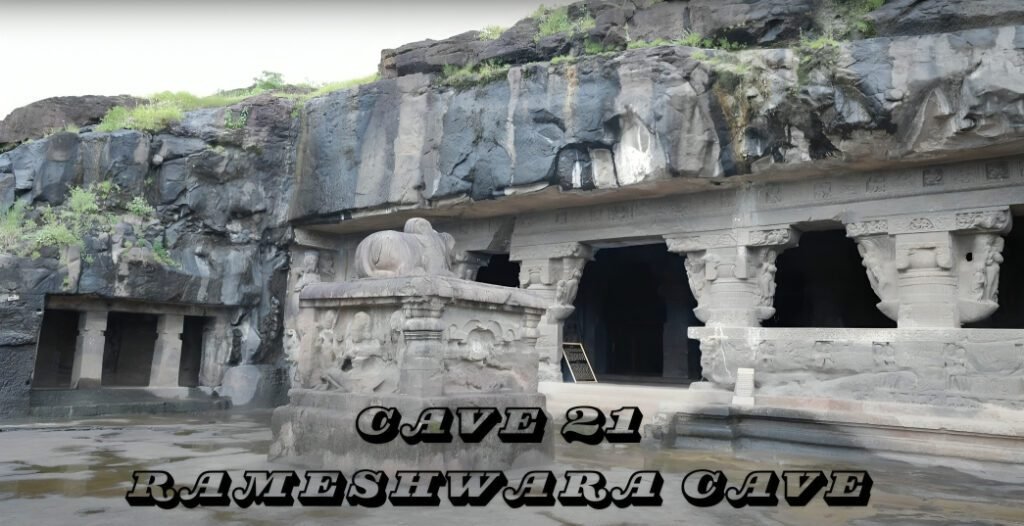
Pilasters and Pillars: The cave features exquisitely carved pilasters and pillars, showcasing the artistic excellence of the period.
Significance: It serves as an important example of the integration of naturalistic and narrative elements in Hindu temple art.
Entry Sculptures: The entrance of Cave 21 is adorned with beautiful sculptures of river goddesses Ganga and Yamuna, symbolizing purification and sanctity.
Shrines: The cave contains several small shrines dedicated to different deities, emphasizing the diversity of Hindu worship.
Interior Carvings: The inner walls are decorated with intricate carvings of various deities, including Shiva and Parvati.
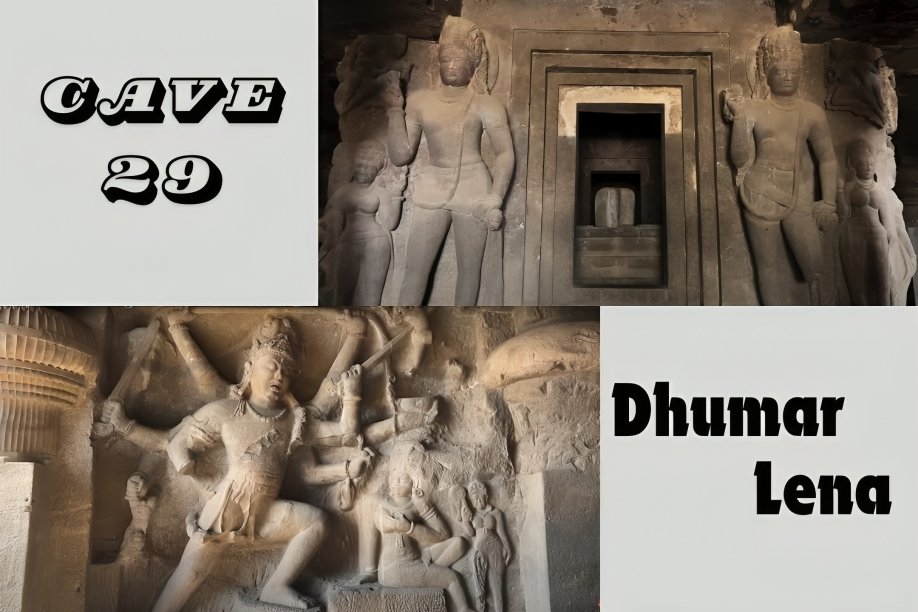
Jain Caves (Caves 30-34)
The Jain caves, although fewer in number, are equally impressive with their detailed carvings and sculptures. These caves emphasize the ascetic nature of Jainism, with simple yet profound depictions of Tirthankaras (Jain spiritual teachers). Cave 32, known as the Indra Sabha, is notable for its elaborate carvings, intricate designs, and a grand assembly hall.
Cave 30 (Chhota Kailasa)
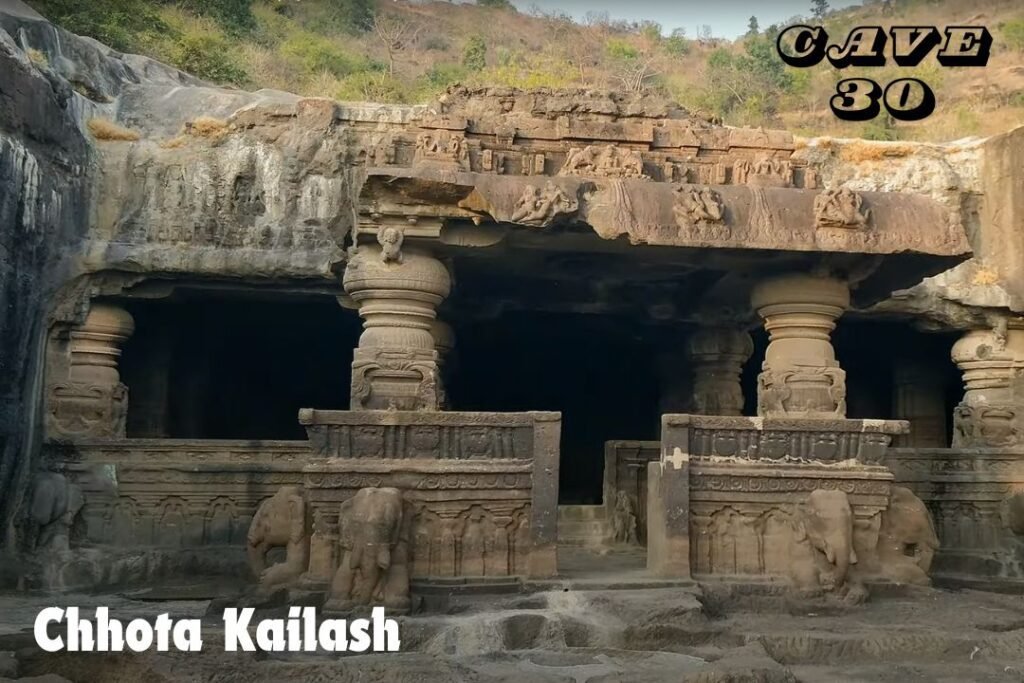
Historical Context: It provides insights into the parallel development of Jain and Hindu rock-cut architecture.
Design Influence: Similar in design to the larger Kailasa temple, but on a smaller scale, reflecting Jain architectural principles.
Tirthankaras: The cave features images of Tirthankaras, highlighting the importance of asceticism in Jainism.
Simplicity: The carvings and sculptures are less ornate compared to Hindu caves, reflecting the Jain emphasis on simplicity and austerity.
Symbolism: The cave’s design and iconography focus on themes of renunciation and spiritual liberation, central to Jain philosophy.
Cave 32 (Indra Sabha)
Two-story Structure: Cave 32, known as Indra Sabha, is a grand two-story structure with richly carved pillars and panels.
Assembly Hall: The ground floor features a spacious assembly hall with a high ceiling, used for congregational purposes.
Mahavira Statue: A significant sculpture of Lord Mahavira, the 24th Tirthankara, is the focal point of the cave, emphasizing Jain worship practices.
Elaborate Carvings: The cave contains intricate carvings of various deities, Yakshas, and Yakshinis, illustrating the integration of local deities into Jain iconography.
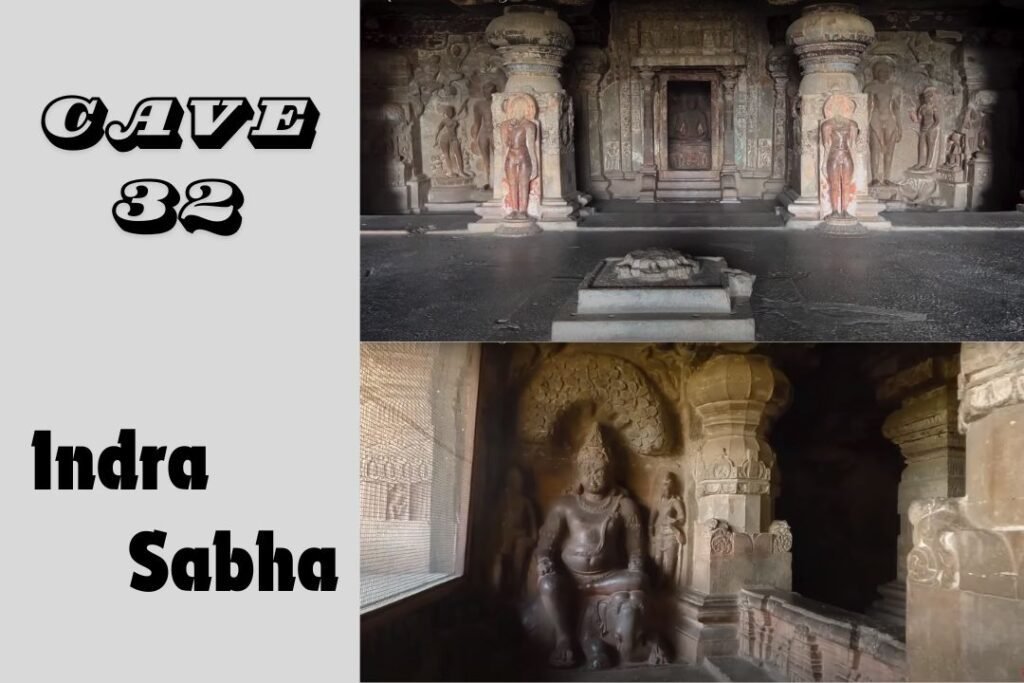
Cultural Significance: It serves as an important example of Jain rock-cut architecture and art, showcasing the religious and cultural contributions of the Jain community.
Cultural and Spiritual Importance
The Ellora Caves are a remarkable representation of the cultural and religious plurality of ancient India. The coexistence of Buddhist, Hindu, and Jain monuments in a single complex signifies the tolerance and mutual respect among different faiths. These caves served not only as religious centers but also as hubs of learning and culture.
The artistic styles found in the Ellora Caves reflect a mix of influences from different regions and periods, showcasing the dynamic exchange of ideas and techniques. The caves are also an important center for spiritual learning, attracting scholars and monks from all over Asia.
Nearby Attractions
Shri Ghrishneshwar Temple
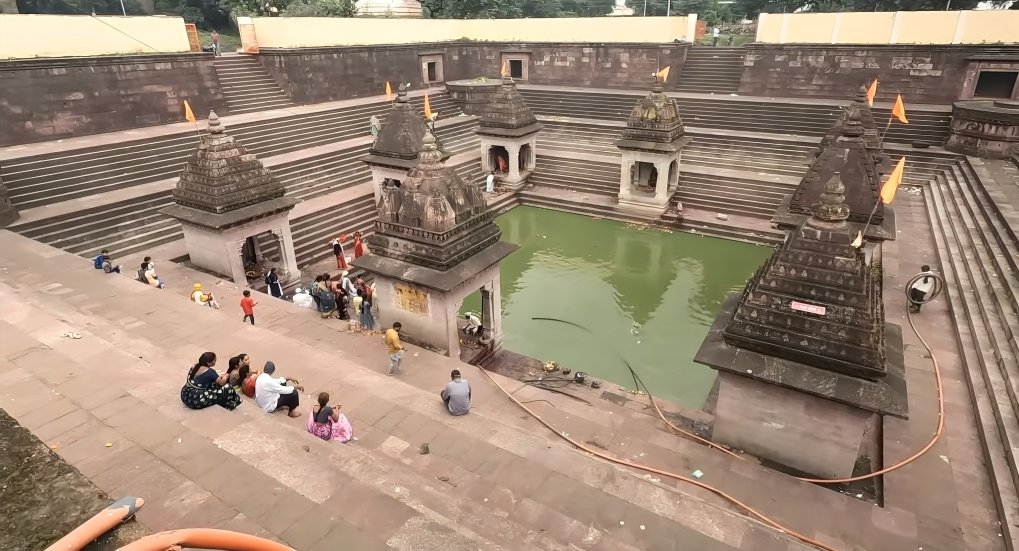
One of the twelve Jyotirlingas, this ancient temple dedicated to Lord Shiva is renowned for its spiritual significance and stunning Maratha architecture.
Shivalaya Tirth Kund
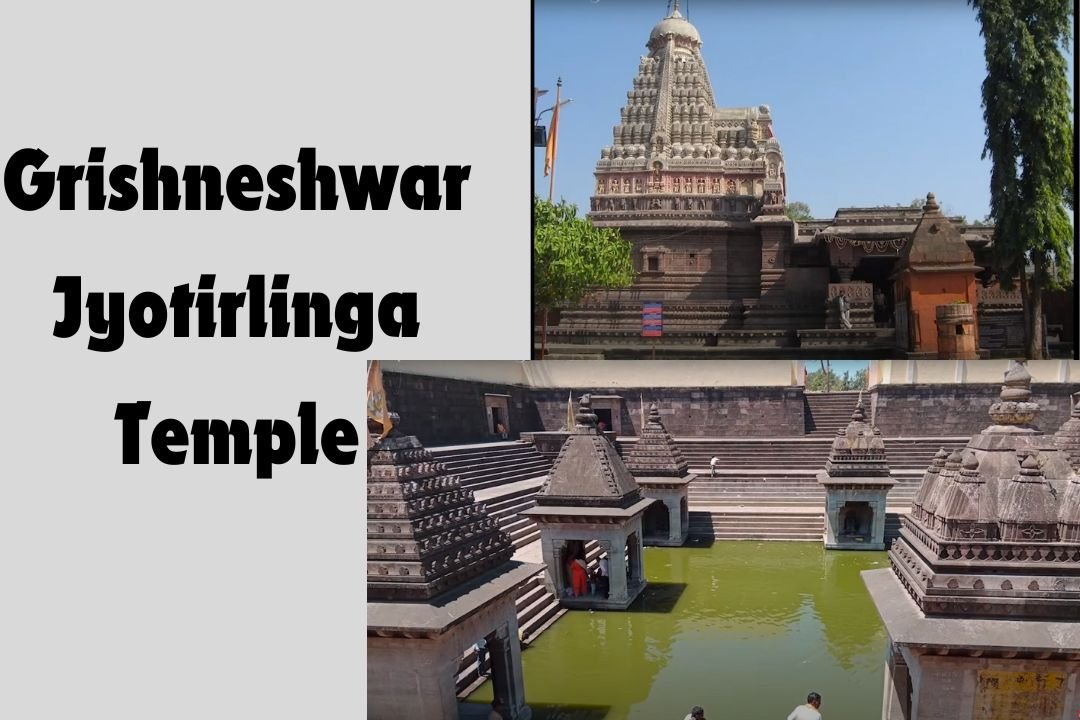
A sacred water tank near the Grishneshwar Temple, believed to have purifying properties and used by devotees for ritual bathing.
Siddheshwar Mahadev Temple
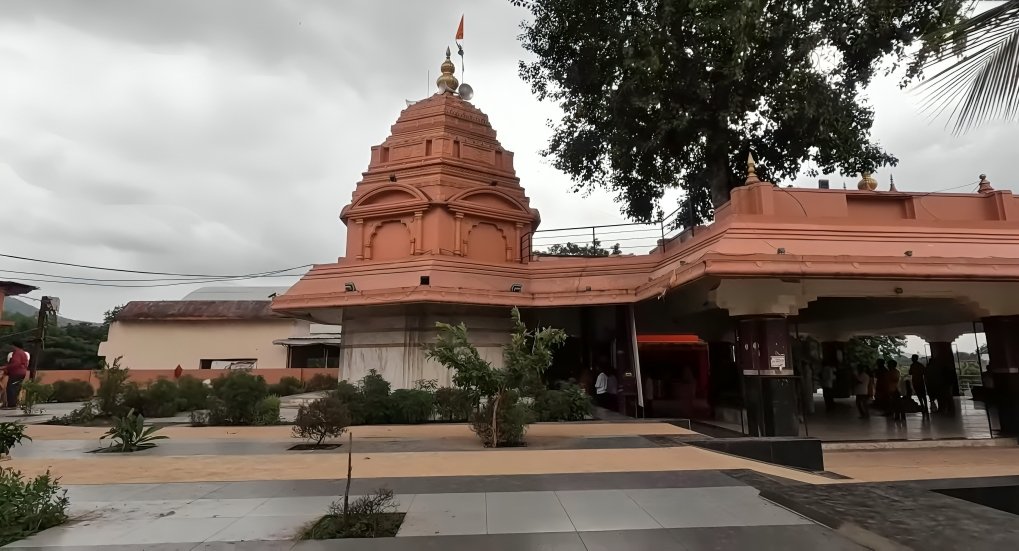
A revered temple dedicated to Lord Shiva, known for its serene environment and spiritual ambiance, attracting devotees seeking peace and blessings.
Bhadra Maruti Temple
Location: The Bhadra Maruti Temple is situated in Khuldabad, just 4 kilometers from the Ellora Caves. It is easily accessible for visitors exploring the Ellora complex.
Deity: The temple is dedicated to Lord Hanumanji and is one of the few temples where Hanumanji is depicted in a reclining position. This unique posture symbolizes Hanuman in a state of deep devotion and rest.
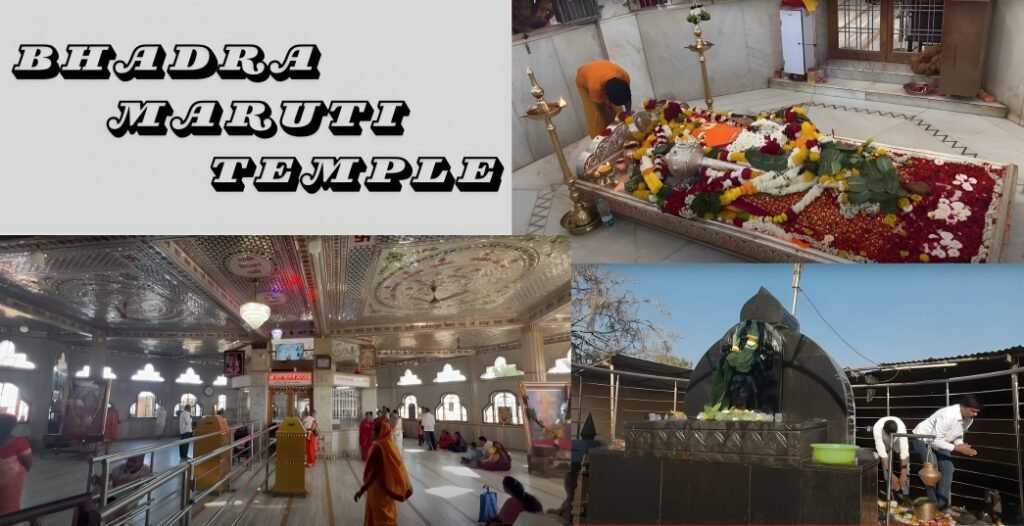
Legend: According to local legend, the temple’s name “Bhadra” comes from the tale of Bhadrasena, a king and ardent devotee of Hanumanji. It is believed that Hanumanji appeared in his dreams and granted him a boon, leading to the construction of this temple.
Architecture: The temple architecture is relatively simple but exudes a serene and spiritual atmosphere. The main sanctum houses the large reclining idol of Hanumanji, adorned with garlands and offerings from devotees.
Festivals: The temple is particularly crowded during Hanuman Jayanti and other major Hindu festivals. Devotees flock to the temple to offer prayers and seek blessings, making it a vibrant center of worship and cultural activity.
Bibi ka Maqbara
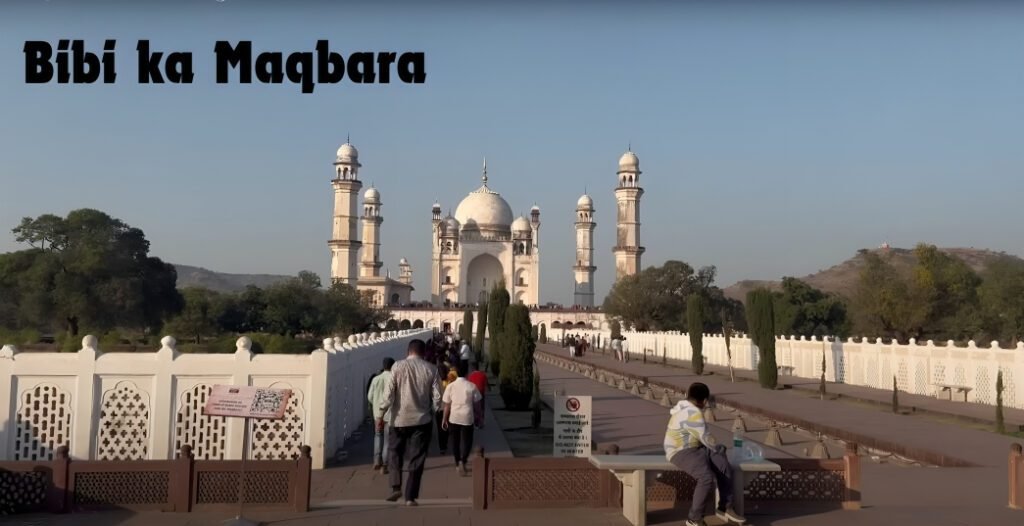
Location: Bibi ka Maqbara is located in Aurangabad (Sambhajinagar), approximately 15 kilometers from the Ellora Caves. Often referred to as the “Taj of the Deccan,” it is a popular tourist attraction.
History: The mausoleum was commissioned by Mughal Emperor Aurangzeb in 1660 in memory of his first wife, Dilras Banu Begum. It was constructed by their son, Prince Azam Shah.
Architecture: Bibi ka Maqbara’s architecture closely resembles that of the Taj Mahal, featuring a central dome, minarets, and intricate marble work. The main tomb is surrounded by lush gardens, pathways, and water fountains, reflecting Mughal garden design principles.
Significance: The monument stands as a testament to Mughal architectural brilliance and is an important cultural heritage site. It offers a glimpse into the grandeur of Mughal art and the deep love of Aurangzeb for his wife.
Visiting Experience: Visitors can explore the beautifully maintained gardens, the intricate marble carvings, and the serene environment of the mausoleum. It provides a tranquil and picturesque setting for photography and reflection.
Daulatabad Fort
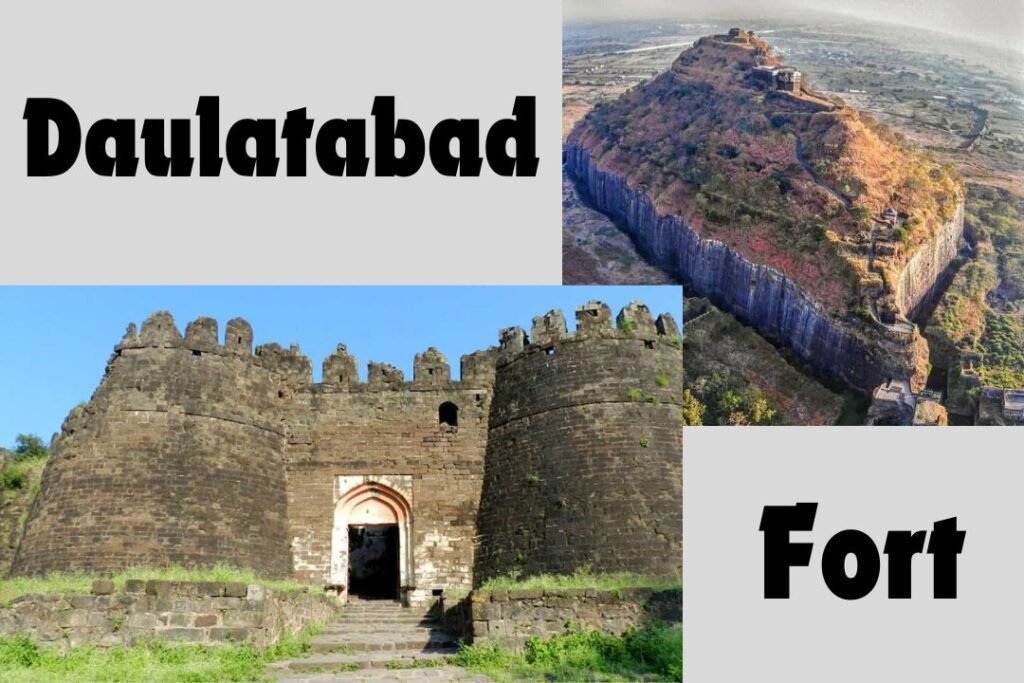
Also known as Devagiri, this impressive medieval fort features robust defense mechanisms and offers panoramic views of the surrounding landscape.
Aurangabad Caves
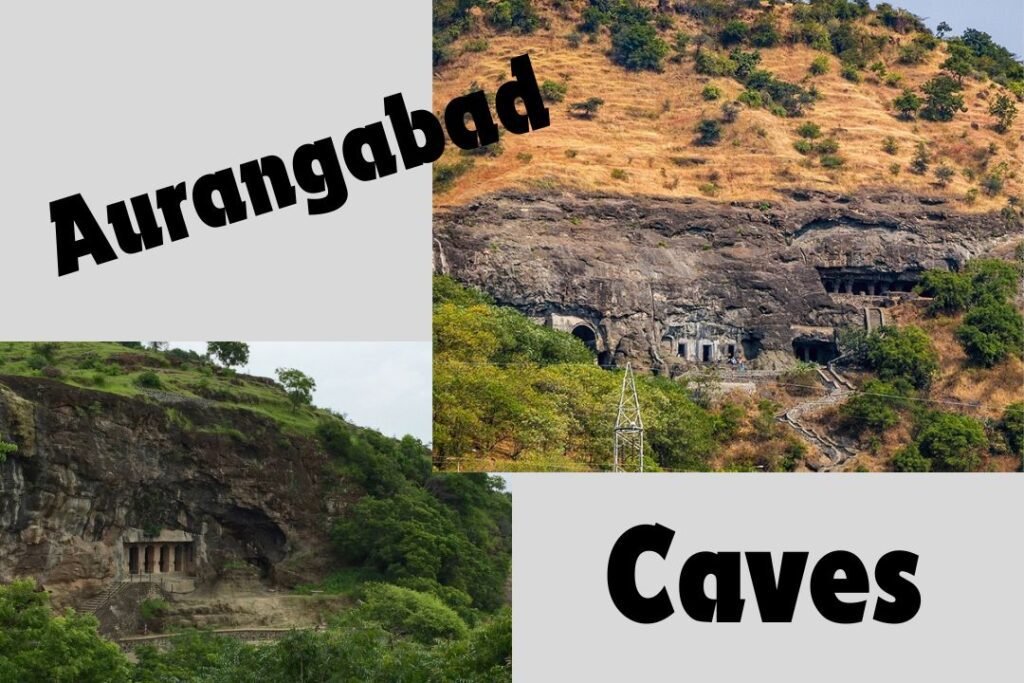
Ancient Buddhist caves dating back to the 6th and 7th centuries, adorned with intricate carvings and providing a tranquil setting for reflection and photography.
How to Get There
By Air: The nearest airport is Aurangabad, approximately 30 km away. Regular flights connect Aurangabad to major cities like Mumbai and Delhi.
By Train: Aurangabad railway station is well-connected to various parts of the country. Trains from major cities like Mumbai, Delhi, and Hyderabad frequently service this station.
By Road: Ellora Caves are accessible by road from Aurangabad. Buses, taxis, and private vehicles can be hired to reach the site. The journey takes about 45 minutes from Aurangabad.
Accommodation
Luxury Hotels
- Vivanta Aurangabad
- WelcomHotel Rama International
- The Meadows Resort and Spa
Mid-Range Hotels
- Hotel Kailas
- Lemon Tree Hotel, Aurangabad
- VITS Hotel, Aurangabad
Budget Hotels
- Hotel Shree Maya
- Hotel New Bharti
- Ajanta Ellora Inn
Alternative Stays
- MTDC Holiday Resort, Ellora
- Guesthouses and Homestays
Travel Tips and Safety Advice
Plan Your Visit
Best Time to Visit: The ideal time to visit the Ellora Caves is from October to March when the weather is pleasant. Avoid the peak summer months (April to June) due to high temperatures and humidity.
Opening Hours: The caves are open from 6 AM to 6 PM and are closed on Tuesdays. Plan to arrive early to avoid the crowds and make the most of your visit.
Entry Fees and Tickets
Indian Citizens: The entry fee is nominal for Indian citizens. Children under 15 years of age are usually free.
Foreign Tourists: The entry fee for foreign tourists is higher then Indian. Check the latest rates and carry sufficient cash as credit/debit cards may not be accepted.
Online Booking: Consider booking tickets online to avoid long queues at the entrance.
Exploring the Caves
Hire a Guide: To fully appreciate the historical and artistic significance of the caves, consider hiring a local guide. Guides are knowledgeable and can provide valuable insights.
Wear Comfortable Shoes: Exploring the caves involves a lot of walking and climbing. Comfortable footwear is essential.
Stay hydrated: Carry a bottle of water, especially in the warmer months. There are stalls outside the caves where you can buy refreshments.
Photography
Camera Rules: Photography is generally allowed, but some caves may have restrictions. Tripods may not be permitted, so check the rules before you start clicking.
Lighting: Natural light is limited inside some caves, so a good camera with low-light capability can be useful.
Health Precautions
Stay Hydrated: Carry and drink plenty of water to avoid dehydration, especially in hot weather.
Sun Protection: Carry hat, sunglasses, and sunscreen to protect yourself from the heat.
First Aid Kit: Carry a basic first aid kit with essentials like band-aids, antiseptic cream, and any personal medications.
Physical Safety
Watch Your Step: The caves and paths can be uneven and slippery. Pay attention to where you are walking and avoid areas that look unstable.
Avoid Strenuous Activity: If you have any health conditions, avoid overexertion. The climb to some caves can be steep.
Insect Protection: Use insect repellent to protect yourself from mosquito bites, especially during the monsoon season.
Personal Belongings
Secure Your Valuables: Keep an eye on your belongings and avoid carrying large amounts of cash or valuables.
Bags and Pockets: Use secure bags with zippers and keep your pockets secure to avoid pickpocketing.
Local Etiquette
Respect the Site: The Ellora Caves are a UNESCO World Heritage Site and hold great historical and cultural significance. Respect the monuments and avoid touching the carvings.
Dress Appropriately: Wear modest clothing, especially when visiting religious sites within the caves.
Follow Instructions: Adhere to any signs or instructions given by the authorities for your safety and the preservation of the site.
Conclusion
The Ellora Caves stand as a testament to the artistic brilliance and spiritual depth of ancient India. Visiting this site offers a profound glimpse into the past, showcasing the architectural genius and religious harmony that existed over a millennium ago. Whether you’re a history buff, an architecture enthusiast, or a spiritual seeker, the Ellora Caves promise an unforgettable journey through time.

Frequently Asked Questions (FAQs)
What are the Ellora Caves?
The Ellora Caves are a complex of 34 rock-cut monasteries and temples located in the Aurangabad (Sambhajinagar) district of Maharashtra, India. They are renowned for their architectural and artistic significance and span three major religions: Buddhism, Hinduism, and Jainism.
Where are the Ellora Caves located?
The Ellora Caves are situated in the village of Verul, around 30 km northwest of Aurangabad (Sambhajinagar), Maharashtra.
What is the best time to visit the Ellora Caves?
The best time to visit the Ellora Caves is from October to March when the weather is pleasant. Avoid the summer months (April to June) due to high temperatures and humidity.
How can I reach the Ellora Caves?
The nearest airport is in Aurangabad (Sambhajinagar), about 30 km away. Aurangabad (Sambhajinagar) is also well-connected by train. From Aurangabad (Sambhajinagar), you can hire a taxi, take a bus, or drive to the Ellora Caves.
What are the opening hours of the Ellora Caves?
Ellora Caves are usually open from 6 am to 6 pm. They are closed on Tuesdays.
How much is the entry fee for the Ellora Caves?
Entry fees vary for Indian citizens and foreign tourists. Indian citizens pay a nominal fee, while foreign tourists pay a higher fee. Children under 15 years are usually free. It’s advisable to check the latest rates and carry sufficient cash.
Are there guides available at the Ellora Caves?
Yes, local guides are available for hire at the Ellora Caves. Hiring a guide can enhance your visit by providing detailed information about the history and significance of each cave.
Can I take photographs inside the Ellora Caves?
Yes, photography is generally allowed inside the Ellora Caves. However, some caves may have restrictions, and the use of tripods may not be permitted.
How long does it take to explore the Ellora Caves?
It typically takes about 4 to 6 hours to explore the main caves at Ellora thoroughly. However, you can spend a full day if you wish to explore at a leisurely pace and visit all 34 caves.
What should I wear when visiting the Ellora Caves?
Wear comfortable clothing and shoes as you will be doing a lot of walking and climbing. It’s also advisable to dress modestly, especially when visiting religious sites within the caves.
Are there any facilities for food and drinks at the Ellora Caves?
There are small food stalls and vendors near the entrance of the Ellora Caves where you can buy snacks and drinks. It’s a good idea to carry water and some light snacks with you.
Is there any accommodation near the Ellora Caves?
Yes, there are several accommodation options near the Ellora Caves, ranging from luxury hotels to mid-range and budget options. Aurangabad (Sambhajinagar), about 30 kilometers away, also offers a variety of hotels.
What are the main highlights of the Ellora Caves?
Key highlights include Cave 16 (Kailasa Temple), which is a massive monolithic rock-cut temple dedicated to Lord Shiva, Cave 10 (Vishvakarma Cave) known for its acoustic excellence, and Cave 32 (Indra Sabha) which is a significant Jain cave.
Are the Ellora Caves wheelchair accessible?
The terrain at Ellora Caves can be uneven and rocky, making it challenging for wheelchair access. However, some parts of the site may be accessible with assistance.
What other attractions are near the Ellora Caves?
Nearby attractions include the Bhadra Maruti Temple, Bibi ka Maqbara, and Shri Ghrishneshwar Temple. These sites offer additional cultural and historical insights and are worth visiting.

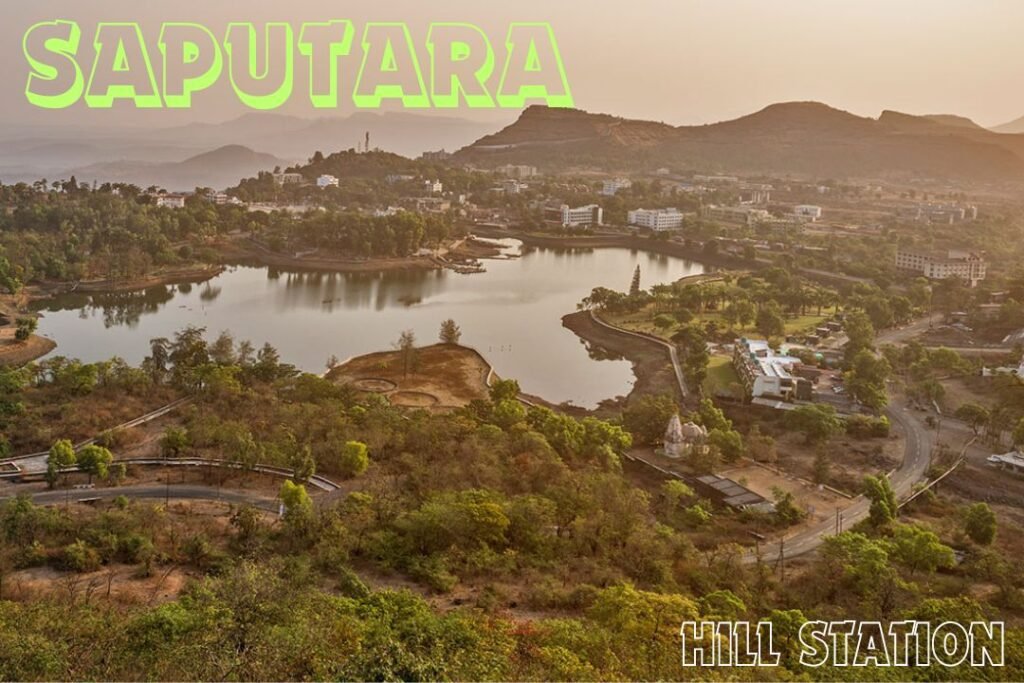
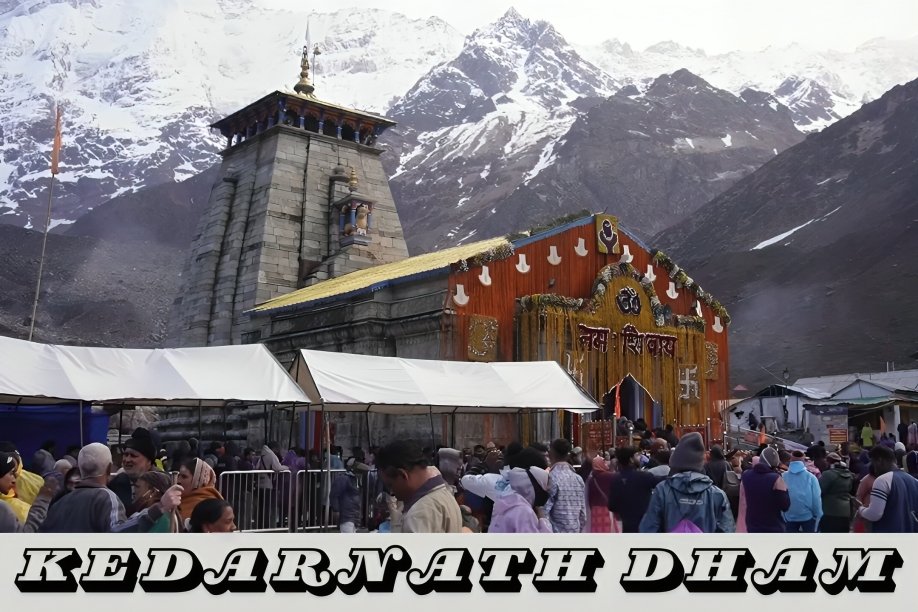
Pingback: Ajanta Caves: India's 1st World Heritage Site - GujjuTraveling
Pingback: Girnar: The Magnificent Highest Mountain in Gujarat - GujjuTraveling
Pingback: Mahakaleshwar Temple: A Sanctuary of Divine Energy - GujjuTraveling